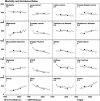Time trends of incidence of age-associated diseases in the US elderly population: Medicare-based analysis
- PMID: 23482353
- PMCID: PMC3684110
- DOI: 10.1093/ageing/aft032
Time trends of incidence of age-associated diseases in the US elderly population: Medicare-based analysis
Abstract
Objectives: time trends of age-adjusted incidence rates of 19 ageing-related diseases were evaluated for 1992-2005 period with the National Long Term Care Survey and the Surveillance, Epidemiology and End RESULTS Registry data both linked to Medicare data (NLTCS-Medicare and SEER-Medicare, respectively).
Methods: the rates were calculated using individual medical histories (34,077 individuals from NLTCS-Medicare and 199,418 from SEER-Medicare) reconstructed using information on diagnoses coded in Medicare data, dates of medical services/procedures and Medicare enrolment/disenrolment.
Results: increases of incidence rates were dramatic for renal disease [the average annual percent change (APC) is 8.56%, 95% CI = 7.62, 9.50%], goiter (APC = 6.67%, 95% CI = 5, 90, 7, 44%), melanoma (APC = 6.15%, 95% CI = 4.31, 8.02%) and Alzheimer's disease (APC = 3.96%, 95% CI = 2.67, 5.26%), and less prominent for diabetes and lung cancer. Decreases of incidence rates were remarkable for angina pectoris (APC = -6.17%, 95% CI = -6.96, -5.38%); chronic obstructive pulmonary disease (APC = -5.14%, 95% CI = -6.78,-3.47%), and ulcer (APC = -5.82%, 95% CI = -6.77,-4.86%) and less dramatic for carcinomas of colon and prostate, stroke, hip fracture and asthma. Incidence rates of female breast carcinoma, myocardial infarction, Parkinson's disease and rheumatoid arthritis were almost stable. For most diseases, an excellent agreement was observed for incidence rates between NLTCS-Medicare and SEER-Medicare. A sensitivity analysis proved the stability of the evaluated time trends.
Conclusion: time trends of the incidence of diseases common in the US elderly population were evaluated. The results show dramatic increase in incidence rates of melanoma, goiter, chronic renal and Alzheimer's disease in 1992-2005. Besides specifying widely recognised time trends on age-associated diseases, new information was obtained for trends of asthma, ulcer and goiter among the older adults in the USA.
Keywords: Medicare; age-associated disease; comorbidity; disease onset; older people; time trends.
Figures

References
-
- Warren JL, Klabunde CN, Schrag D, Bach PB, Riley GF. Overview of the SEER-Medicare data: content, research applications, and generalizability to the United States elderly population. Medical Care. 2002;40:IV-3–IV-18. - PubMed
-
- Akushevich I, Kravchenko J, Ukraintseva S, Arbeev K, Yashin AI. Circulatory diseases in the U.S. elderly in the linked National Long Term Care Survey-Medicare database: population-based analysis of incidence, comorbidity, and disability. Res Aging. 2012 June 11; doi:10.1177/0164027512446941 (epub ahead of print) - PMC - PubMed
-
- Keyfitz. Sampling variance of the standardized mortality rates. Hum Biol. 1966;38:309–17. - PubMed
-
- Truelsen T, Mahonen M, Tolonen H, Asplund K, Bonita R, Vanuzzo D. Trends in stroke and coronary heart disease in the WHO MONICA Project. Stroke. 2003;34:1346–52. (Research Support, Non-U.S. Gov’t Research Support, U.S. Gov’t, P.H.S.) - PubMed
Publication types
MeSH terms
Grants and funding
LinkOut - more resources
Full Text Sources
Other Literature Sources
Medical

